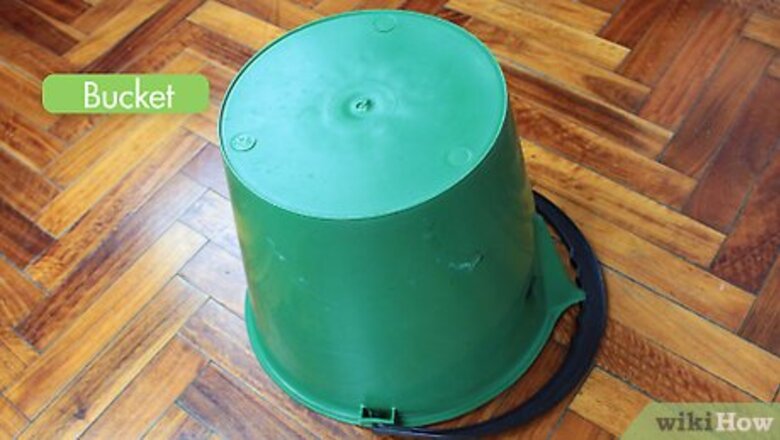
views
Creating Your Bucket Drum Set
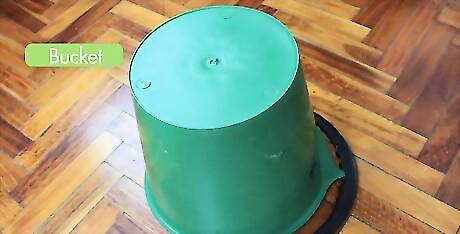
Look for a large plastic bucket. The key component of your bucket drum set is going to be the bucket. A 15 liter (4 US gal) bucket is usually a good size for someone of an average height. You can find large plastic buckets at hardware stores or by asking friends or family if they have an empty plastic bucket you can use. You will also need a stool or another bucket of equal or lesser height that you can sit on when you drum.
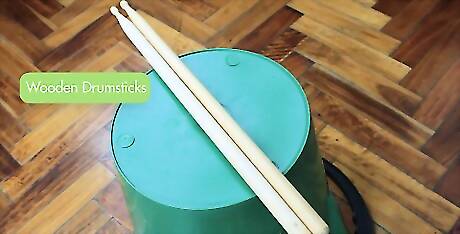
Get wooden drumsticks. The second key component of your bucket drum set is a pair of wooden drumsticks. Look for drumsticks at your local music supply store or online. You can also use metal drumsticks, but they are often heavier and more difficult to use for beginner drummers.
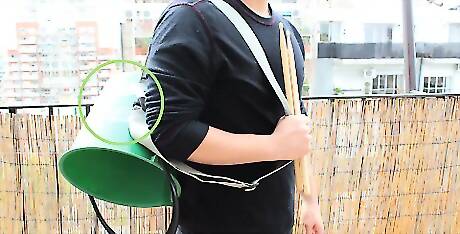
Consider making a strap to carry your bucket drum. If you plan to move around with your bucket drum set, you can make it portable by making a strap for the bucket drum out of duct tape and rope. Begin by wrapping duct tape around the bucket, a few inches from the bottom of the bucket. Wrap the duct tape around once and then once more again. At the end of the second layer of tape, pinch one inch of the tape to make a loop. Continue wrapping the tape once you make the first loop for five to ten inches and then pinch the tape again to create a second loop. A wider gap between the loops works best if you want to tie the bucket around your waist. A narrower gap between the loops works best if you plan to carry the bucket via a shoulder strap. Wrap the tape around the bucket one more time, layering over the loops so they are double layered. This will make them strong enough to withstand the pull of the rope. Turn the bucket upside down, with the opening on the ground. Then, put duct tape on the bucket vertically over the wrapped section to secure it further. Do this three to four times. Thread the rope through the loops and tie the bucket to your waist or make a shoulder strap with the rope and carry the bucket that way. EXPERT TIP Bart Robley Bart Robley Drummer, Drum Teacher, and Author Bart Robley is a Drummer, Drum Teacher, and Author based in Ontario, California. Bart has been sharing his expertise in drumming knowledge through teaching for over 30 years. He makes his teachings globally accessible by offering lessons in an online format. Bart has authored three instructional books and created three instructional DVDs. He received a Bronze Telly Award in 2009 for his DVD "School Of Hard Rocks. Additionally, Bart has been the drummer for the Sam Morrison Band for over 25 years. Bart Robley Bart Robley Drummer, Drum Teacher, and Author Buckets and cans make creative drums. For creative drumming, take some buckets or paint cans from around the house and use them as makeshift drums. Experiment with different sounds and beats. It's a fun way to spark your creativity and work on your rhythms.
Playing a Basic Drum Beat
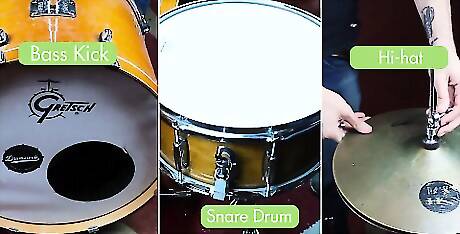
Be aware of the three elements of a basic drum beat. If you are new to playing drums, it is important that you learn the three elements of a basic drum beat: the bass, the snare, and the hi-hat. These three elements can be played to a certain time signature or rhythm to then create a basic drum beat. The bass is the deeper note on a drum beat. It is often played on regular drums by hitting a pedal on the ground that then hits the middle of a kick drum. The snare is the complementary note to the bass. It is often played on regular drums by hitting the rim of the drum and the middle of the drum with the drumstick. The hi-hat is also known as the lightest note in a drum beat. In a regular drum kit, the hi-hat is made of two cymbals mounted on a stand.
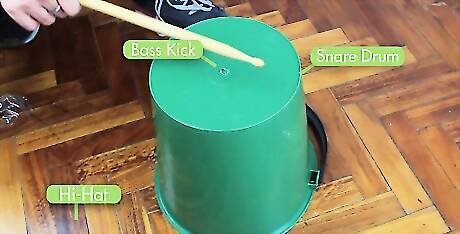
Identify the three elements of a drum beat on the bucket. To create a basic beat on the bucket drum, you will first need to identify the three elements of a drum beat that you can make on the bucket. Begin by placing the bucket one to two feet in front of the stool on a hard, concrete floor. Sit down on the stool with a drumstick in each hand. The plastic bucket should be between your legs and you should be able to hit the bucket easily with the drumsticks. Use the middle of the bucket as the bass note. Place one foot on the bottom edge of the bucket and tilt it slightly toward you. Then, use one of the drumsticks to hit the middle of the bucket. This should produce a deep bass note. You can also simply hit the middle of the bucket to make a bass note, but tilting the bucket will create a deeper sound. Use the rim of the drum as the snare note. Hit the rim of the drum and the middle of the drum at the same time to make a snare note. Use the concrete floor as the hi-hat. To make a hi-hat note, you can lean down and hit the concrete floor. This should create a nice, sharp hi-hat note.
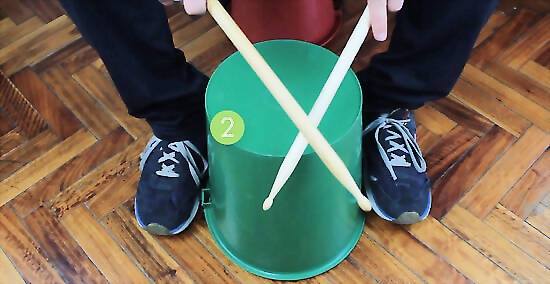
Combine the hi-hat, the snare, and the bass to make a basic beat. Once you have identified the three elements of a drum beat on the bucket (and on the floor), you can put them together to make a basic drum beat. Start by hitting your sticks together four times as this will help you to remember the 4-beat count. Then, tilt the bucket slightly and hit the middle of the bucket with one drum stick to make a bass note. Then, release the bucket and hit the rim and middle of the bucket to make a snare note. Play the bass note and then the snare note four time each, creating a 4-beat rhythm. After you have played the bass and the snare four times through, add in the hi-hat. Lean down and hit the floor with the other drum stick in a quick 1-2-1-2 rhythm. Continue to play the bass and the snare with the other drum stick to a 4-beat count.
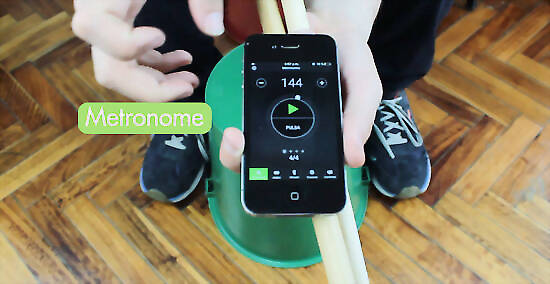
Practice the basic beat at different tempos. After enough practice, you should be able to play the bass, the snare, and the hi-hat at a 4-beat count at a regular tempo. You can try to speed up your playing so you are drumming faster to the 4-beat count and the beat sounds more rapid. Speeding up the tempo will be good practice for doing more complex beats on the bucket drum, as it will get you more accustomed to playing to a different rhythms and speeds.
Doing More Complex Drumming
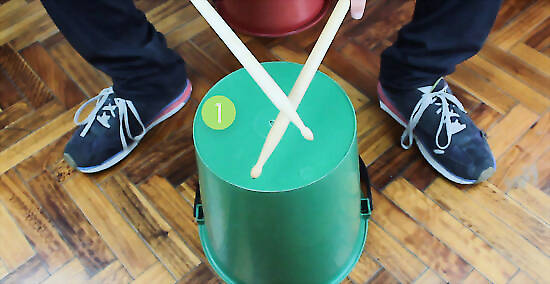
Practice a two handed drum beat. A two handed drum beat is not too difficult to learn on its own. But it will allow you to learn more complex drum beats and also improvise your own drum beats. This two handed drum beat involves hitting the bass once with one stick, hitting the snare with one stick, hitting the bass twice with one stick, and then hitting the snare with one stick. You will always hit the bass note with your right hand and the snare note with your left hand. Practice this beat on the bucket drum. It can help to say out loud “boom” as you hit the bass, or middle of the bucket, and “ghat” as you hit the snare, or the rim of the bucket. The two handed drum beat should follow the pattern: “boom, ghat, boom, boom, ghat”. Make sure your right hand is making the “boom” and your left hand is making the “ghat”.

Add extra beats to the two handed drum beat. Once you get the hang of the two handed drum beat, add extra beats to create some variation in your drumming. You can string these extra beats together to create a longer drumming routine. Practice this by saying “boom” and “ghat” out loud as you hit the bucket with the drum sticks. Run through the first “boom, ghat, boom, boom, ghat” and repeat it a second time. On the second run though, add an extra “boom” or bass note hit, so the pattern becomes “boom,ghat, boom, boom, ghat, boom”. Then, add in three hits with your right drumstick and then three hits with your left drumstick. This should create a “boom, boom, boom” and then “ghat, ghat, ghat” rhythm. Finish with one hit of the right drumstick and one hit of the left drumstick. This will create a 123-123-1-2 pattern, where you do three quick bass hits, three quick snare hits, one bass hit and one snare hit.

Try a stick flip. A stick flip is a stickhandling trick that you can try to add some complexity to your bucket drumming. Start by practicing flipping one stick in your hand, throwing it and flipping it once in the air. Do this several times so you get a feel for how the stick should flip in your hand. You can then integrate the stick flip into your drumming routine to make your drumming more impressive. Do this by flipping one stick in one hand while you are playing the drum beat with the drumstick in your other hand. Play a basic beat first with both sticks, such as hitting the drum once with one stick and then hitting the drum once with the other stick. Then, as you hit the drum again with one stick, flip the stick in your other hand. Speed this up so that eventually you are playing a drum beat at a 4-count and flipping one stick in your hand. You can then add the stick flip to any of the drum beats you are playing on the bucket drum to make your routine more interesting.


















Comments
0 comment